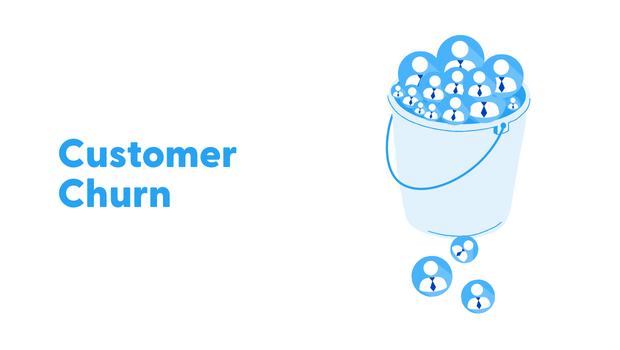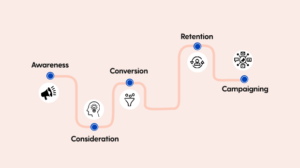Customer churn, also known as customer turnover or attrition rate, measures how many customers a business loses over a given period. To calculate customer churn, you will need to identify the number of customers that you had at the beginning of the period (such as the beginning of a month or a year), and the number of customers that you have at the end of the period.
Formula for Calculating Customer Churn
(Number of customers at the beginning of the period – Number of customers at the end of the period) / Number of customers at the beginning of the period
For example, if a business had 1000 customers at the beginning of the month and 900 customers at the end of the month, the customer churn rate for that month would be:
(1000 – 900) / 1000 = 10%
This means that the business lost 10% of its customers during that month.
Types of Customer Churn
There are two main types of customer churn: voluntary and involuntary.
Voluntary churn occurs when a customer actively chooses to cancel a service or product. This can happen for a variety of reasons, such as dissatisfaction with the service, finding a better deal elsewhere, or simply losing interest. The formula for calculating voluntary churn rate is:
Voluntary Churn Rate = (Number of Voluntarily Churned Customers) / (Total Number of Customers)
For example, if a company has 100 customers and 20 of them voluntarily cancel their service within a given period, the voluntary churn rate would be 20%.
Involuntary churn occurs when a customer is forced to cancel a service or product due to non-payment or changes that render the service no longer useful.
Formula for Calculating the Involuntary Churn Rate
Involuntary Churn Rate = (Number of Involuntarily Churned Customers) / (Total Number of Customers)
For example, if a company has 100 customers and 10 of them are involuntarily disconnected within a given period, the involuntary churn rate would be 10%.
It’s important to note that, in practice, it can be difficult to differentiate between voluntary and involuntary churn; many companies don’t differentiate between the two.
Overall churn rate = (Number of Churned Customers) / (Total Number of Customers)
How to Measure Customer Churn
There are several key performance indicators (KPIs) and metrics that can be used to measure customer churn:
- Churn rate: This is the percentage of customers who cancel their subscriptions or stop using a product or service over a certain period.
- Customer lifetime value (CLV): This is the total value a customer will bring to a company over the course of their relationship.
- Net Promoter Score (NPS): This measures the likelihood of a customer recommending a product or service to others.
- Customer Satisfaction (CSAT): This measures customer satisfaction with a product or service.
- Retention rate: The percentage of customers who continue to use a product or service over a certain period.
- Monthly Recurring Revenue (MRR) Churn: The monthly loss of recurring revenue due to customer cancellations
- Acquisition-Retention Rate: The ratio of new customers acquired to existing customers retained
- Revenue Churn: The dollar value lost due to customer cancellations
These KPIs and metrics can help a company understand the reasons behind customer churn and take steps to reduce it.
Also, read:
Importance of Analyzing Customer Churn
Customer churn is an important metric for businesses to track, as it can significantly impact a company’s revenue and profitability. High levels of customer churn can indicate that a business is losing market share or that customers are not satisfied with the products or services being offered. By tracking customer churn, businesses can identify and address any issues causing customers to leave, which can help retain existing customers and attract new ones.
There are several ways that businesses can use customer churn data to improve their operations and drive growth. For example, businesses can analyze customer churn data to identify trends or patterns that may be contributing to customer churn. They can also use this data to identify areas of the customer experience that may be causing frustration or dissatisfaction and take steps to address these issues. Additionally, businesses can use customer churn data to inform their marketing and sales efforts by targeting their efforts at retaining existing customers or attracting new ones.
Read more:
10 Reasons Why Customers Churn
- Poor customer service
- High prices
- Lack of personalization
- Lack of innovation
- Poor communication: Customers may leave if they feel that the company is not keeping them informed about important changes or updates.
- Complex product/service: Customers may leave if they find the product/service is hard to understand and use.
- Unreliable product/service: Customers may leave if they find that the product or service is frequently unavailable or breaks down.
- Unattractive loyalty program: Customers may leave if they don’t see value in the company’s loyalty program.
- Lack of trust: Customers may leave if they don’t trust the company’s brand, values, or business practices.
- Better alternatives: Customers may leave if they find a better alternative that better fits their needs.
Also, read:
Customer Retention
Customer Segmentation
Impact of Customer Churn
Some examples of how customer churn can impact a business include:
- Reduced Revenue: When customers churn, they stop purchasing products or services from a business, which can lead to a decrease in overall revenue.
- Increased Acquisition Costs: Businesses must spend more money to acquire new customers to replace those who have churned, which can be costly and time-consuming.
- Decreased Customer Lifetime Value: Losing customers can also lead to a decrease in customer lifetime value, as businesses will not have the opportunity to sell to those customers for as long.
- Negative Impact on Brand Reputation: High churn rates can also negatively impact a business’s brand reputation, as it may indicate poor customer service or a lack of quality products or services.
- Decreased Business Efficiency: Churn can also lead to decreased business efficiency, as businesses must devote resources to acquiring and retaining customers.
To mitigate the impact of customer churn, businesses can focus on improving customer retention through effective marketing and customer service strategies and addressing any underlying issues that may be causing customers to leave. Additionally, analyzing customer data and identifying at-risk customers can help businesses proactively address potential churn issues.
Also, read:
11 Strategies to Reduce Customer Churn
- Identify the reasons for customer churn: To reduce customer churn effectively, it’s important first to understand the reasons why customers are leaving. This can be done through customer journey mapping, customer surveys, focus groups, or other methods of gathering customer feedback.
- Improve customer communication: Regularly check in with customers and address any concerns or issues they may have to build trust and loyalty.
- Personalize the customer experience: Use data to create personalized experiences for customers, such as targeted marketing and tailored product recommendations.
- Provide excellent customer service: Train employees to handle customer complaints and issues promptly and effectively.
- Monitor and measure customer churn: Track the rate of customer churn and use that information to identify patterns and trends that can inform strategies to reduce it.
- Implement a Net Promoter Score (NPS) system: NPS is a way to measure customer loyalty and satisfaction by asking customers how likely they are to recommend your company to others.
- Use analytics to identify at-risk customers: Identify customers who are at risk of leaving and intervene with targeted campaigns to keep them engaged.
- Enhance the product and service offerings: Continuously improve your products and services to match customer needs and preferences.
- Invest in Customer Retention strategies for your high CLV cohorts: Consider offering incentives to encourage customers to continue doing business with your company. This could include loyalty programs, special offers, or personalized recommendations based on customers’ past purchases.
- Consider incentives for long-term commitments: Offer special deals or discounts for customers who commit to longer-term contracts.
- Conduct post-churn analysis: Understand why customers are leaving by conducting surveys, interviews or focus groups, and use that information to improve your retention strategies.
Examples:
- A telecommunications company might use personalized marketing to target customers who are nearing the end of their contract, offering them incentives to renew.
- An e-commerce company might use analytics to identify customers who have high lifetime value and target them with loyalty rewards and special deals to keep them engaged.
- A software company might conduct post-churn analysis to understand why customers are canceling their subscriptions and use that information to improve their product and customer service.
Using Customer Data and Analytics to Reduce Customer Churn
One way to use data and analytics to reduce churn is by analyzing customer behavior, such as the features or aspects of the product or service that are most important to them and which are driving them away.
Companies can also use data to segment their customer base and identify at-risk groups, such as customers who have recently had a negative experience or who have been with the company for a long time but have not recently engaged with the product or service. Predictive churn analysis, frequency churn, and cohort analysis can be used to identify potential customers who are at risk of churning.
Another way to use data and analytics to reduce churn is by measuring customer satisfaction and engagement. Surveying customers to gather feedback on their experience with the product or service can provide valuable insights into what the company is doing well and where improvements are needed.
However, it’s important to remember that churn doesn’t tell the whole story. It’s only a measure of how many customers have left. It doesn’t provide information on why they left or how much they were worth to the company.
Additionally, churn may not capture important customer activities, such as those who are not actively using the product but are still subscribed to the service or who have moved to a different plan. Therefore, it’s important to track other metrics in addition to churn, such as customer lifetime value, retention rate, and net promoter score. Combining these metrics can provide a more complete picture of the customer experience and help companies make more informed decisions about reducing churn.
Conclusion
In conclusion, understanding and reducing customer churn is crucial in today’s competitive business environment. However, many organizations struggle with implementing effective customer retention strategies due to a lack of robust data infrastructure. A data warehouse can serve as the central repository for all of an organization’s data, providing a single source of truth for decision-making.
Saras Analytics offers a comprehensive eCommerce data integration solution and fractional data team to help businesses set up their analytics and reporting systems and leverage their data to drive customer retention efforts. With expertise in implementing these solutions for hundreds of brands and agencies, Saras Analytics can provide the necessary support to help businesses succeed in identifying and retaining their most profitable customers.













